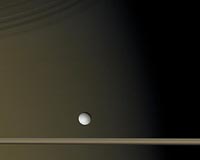 |
Pasadena CA (JPL) Apr 05, 2010 In a special double flyby early next week, NASA's Cassini spacecraft will visit Saturn's moons Titan and Dione within a period of about a day and a half, with no maneuvers in between. A fortuitous cosmic alignment allows Cassini to attempt this doubleheader, and the interest in swinging by Dione influenced the design of its extended mission. The Titan flyby, planned for Monday, April 5, will take Cassini to within about 7,500 kilometers (4,700 miles) of the moon's surface. The distance is relatively long as far as encounters go, but it works to the advantage of Cassini's imaging science subsystem. Cassini's cameras will be able to stare at Titan's haze-shrouded surface for a longer time and capture high-resolution pictures of the Belet and Senkyo areas, dark regions around the equator that ripple with sand dunes. In the early morning of Wednesday, April 7 in UTC time zones, which is around 9 p.m. on Tuesday, April 6 in California, Cassini will make its closest approach to the medium-sized icy moon Dione. Cassini will plunge to within about 500 kilometers (300 miles) of Dione's surface. This is only Cassini's second close encounter with Dione. The first flyby in October 2005, and findings from the Voyager spacecraft in the 1990s, hinted that the moon could be sending out a wisp of charged particles into the magnetic field around Saturn and potentially exhaling a diffuse plume that contributes material to one of the planet's rings. Like Enceladus, Saturn's more famous moon with a plume, Dione features bright, fresh fractures. But if there were a plume on Dione, it would certainly be subtler and produce less material. Cassini plans to use its magnetometer and fields and particles instruments to see if it can find evidence of activity at Dione. Thermal mapping by the composite infrared spectrometer will also help in that search. In addition, the visual and infrared mapping spectrometer will examine dark material found on Dione. Scientists would like to understand the source of this dark material. Cassini has made three previous double flybys and another two are planned in the years ahead. The mission is nearing the end of its first extension, known as the Equinox mission. It will begin its second mission extension, known as the Solstice Mission, in October 2010.
+ The Titan flyby - T67
Share This Article With Planet Earth
Related Links Saturn at JPL Explore The Ring World of Saturn and her moons Jupiter and its Moons The million outer planets of a star called Sol News Flash at Mercury
 Cassini Shows Saturnian Roller Derby
Cassini Shows Saturnian Roller DerbyLondon, UK (SPX) Mar 19, 2010 The seemingly serene orb of Saturn is in fact a gas giant with extraordinary patterns of charged particles and rough and tumble roller derbies for rings. Such are the findings of NASA's Cassini spacecraft since its arrival at Saturn in 2004 - they are combined in two review papers to be published in the March 19 issue of the journal Science. "This rambunctious system gives us a new feel fo ... read more |
|
| The content herein, unless otherwise known to be public domain, are Copyright 1995-2010 - SpaceDaily. AFP and UPI Wire Stories are copyright Agence France-Presse and United Press International. ESA Portal Reports are copyright European Space Agency. All NASA sourced material is public domain. Additional copyrights may apply in whole or part to other bona fide parties. Advertising does not imply endorsement,agreement or approval of any opinions, statements or information provided by SpaceDaily on any Web page published or hosted by SpaceDaily. Privacy Statement |